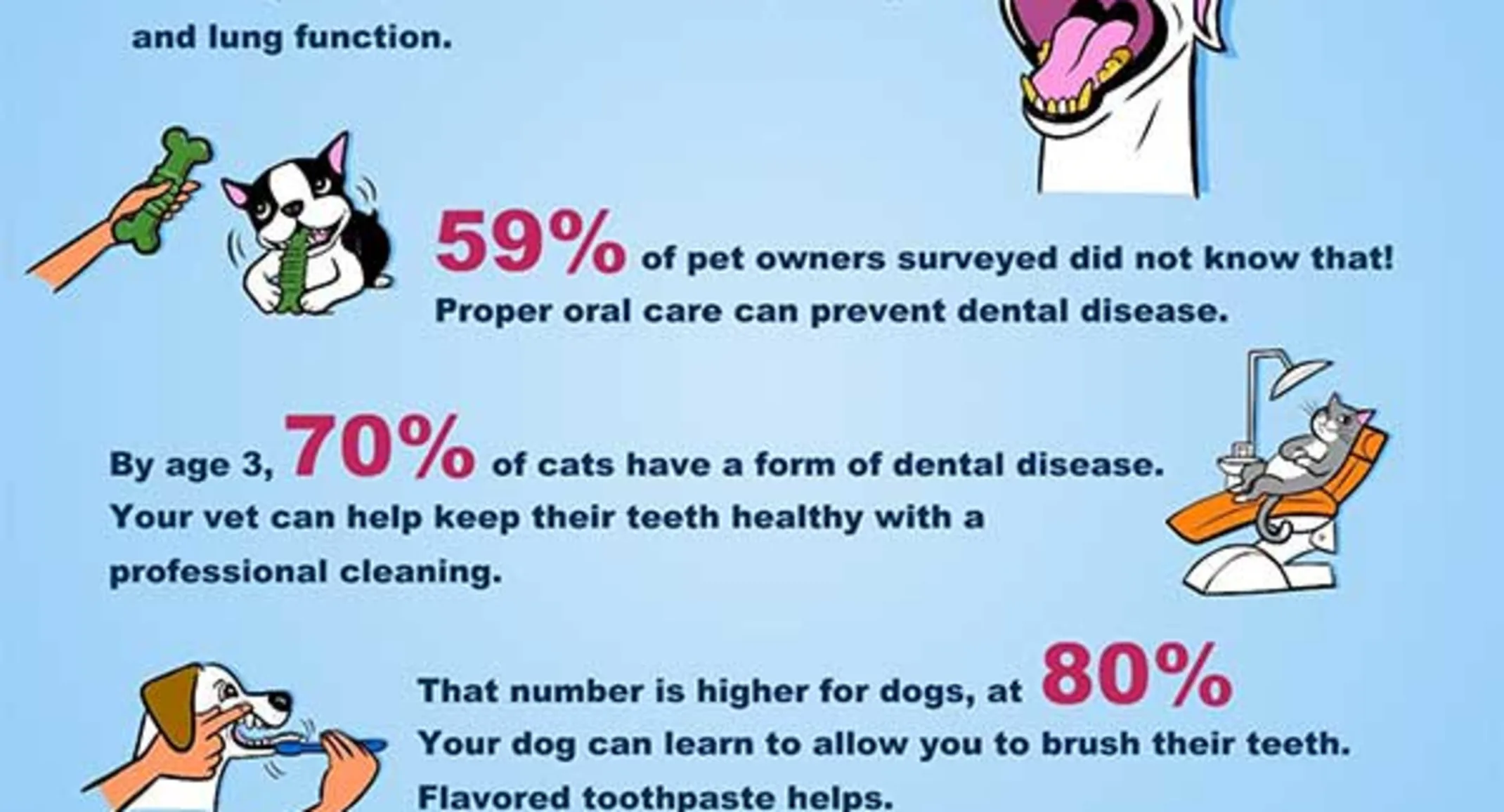Dental Care Helps Your Pet Live Longer
Importance of Dental Care

The most common teeth that are broken are the canine (fang) teeth in the dog and the cat, and the upper fourth premolar, or “carnassial tooth” (large tooth on the top in the back), in dogs.
Unfortunately, only very rarely will our animal patients show discomfort, as they prefer to suffer in silence. This allows owners and veterinarians alike to ignore the problem, as “it doesn’t seem to bother him”. However, we now know that these animals are being affected locally as well as systemically, and ignoring the problem is not a viable option.
Some owners report hearing a sharp cry while their dog is chewing on a hard bone, but then the pet may go right back to chewing. Other times, owners will happen to notice some asymmetry in the mouth from one fang to the other that was not noticed before. Unfortunately, because the 4th premolar tooth is fairly far back in the mouth it is difficult to see. Many times the pet has a fractured tooth and the owner doesn’t know it’s there until an abscess forms. Veterinarians find many of these fractured teeth when they do routine annual exams.
There are two main types of fractures: complicated and uncomplicated.
Uncomplicated slab fractures occur commonly on the carnassial tooth of dogs and typically involve only a small piece of the enamel chipping off. Typically treatment in these cases is limited to monitoring closely by taking dental x-rays at the time of an anesthetic dental cleaning to ensure that the inside parts of the tooth (pulp) have not become damaged or are leading to an abscess. Sometimes further treatment is warranted if it seems that the fracture is very close to reacComplicated slab fractures involve dentin and/or pulp exposure, and will require treatment. There are basically 3 main treatment options:
Surgical extraction of the tooth.
This procedure is typically offered by a general practitioner, although sometimes referral to a veterinary dentist may be offered.
Root canal
An endodontic therapy (similar to what people get) in which the infected pulp is removed and the canals filled with mendicants to discourage future bacterial contamination. It is an option for vital, dying, or non-vital teeth. This procedure is typically performed by a board-certified veterinary dentist.
Vital pulpotomy
Also called “partial coronal pulpectomy,” whereas root canal therapy is a complete pulpectomy. If the entire pulp is removed (like in a root canal), the tooth is dead and will not develop further. Vital pulpotomy allows the tooth to be restored with adhesives and composites, but can only be performed if the fracture is fresh (on a vital tooth) and not yet severely infected; this procedure is especially useful in fractures of immature teeth (dogs and cats less than 18 months of age). This procedure is typically performed by a board-certified veterinary dentist.
We will relay Chelsea’s dental story now to highlight the importance of addressing tooth fractures and why treatment can make a difference for our pets.
Chelsea is an 8 year old Beagle/ Corgi mix whose owners bring her in for regular check-ups.
In February of 2014, Chelsea had her regular yearly wellness exam in which Dr. Lien noted a mild slab fracture of the upper left carnassial tooth – the largest chewing tooth in the upper jaw. Since no obvious pulp exposure was noted, it was presumed to be an “uncomplicated slab fracture,” meaning close monitoring is advised (including regular anesthetic dental cleaning in which x-rays can be taken to ensure the health of the tooth root and pulp).
Incidentally, Chelsea happened to develop an outwardly draining tooth root abscess on her other (right) carnassial tooth later that year while in New Jersey. Between the times of seeing Dr. Lien and her northern vet for the visible abscess, Chelsea must have chewed on something hard that caused another slab fracture her other carnassial tooth which lead to an abscess. The doctor treated with antibiotics and pain medications, but no dental had yet been performed to remove the abscessed tooth. It is important to know that any abscessed tooth must be extracted, because antibiotics only put a band aid on the problem. The tooth is still painful to the pet and can re-abscess at any time.
Dr. Lien saw Chelsea again in March of 2015 and noticed that both her carnassial teeth now had slab fractures, and accompanying them were red, raised bumps above these teeth on the gums, often a sign of an underlying abscess below the tooth. Dr. Lien advised a dental with oral radiographs and warned Chelsea’s owners that extraction of the previously abscessed right carnassial tooth was inevitable, and extraction of the left carnassial tooth was likely, depending on what the x-rays showed and also how the tooth looked once the overlying tartar was scaled away.
A few weeks later, Chelsea came in for her dental procedure. Great care was taken to ensure her safety under anesthesia. Dr. Lien repeated a full physical exam to ensure a healthy heart and lungs and pre-anesthetic bloodwork was performed to ensure proper organ function and adequate red & white blood cells and platelets. An IV catheter was placed so fluids could be running the entire procedure to help keep blood pressure up and thereby keep her organs well perfused. Chelsea had full monitoring equipment, similar to what humans get, to ensure her anesthetic safety – a pulsoximeter to measure oxygen levels, an ECG monitor for heart rate and rhythm, a blood pressure monitor, a body temperature gauge, and capnography to measure breathing rates and CO2 levels. She was intubated to secure her airway and prevent any water and debris from the dental cleaning traveling through her respiratory system and was placed on a heated surgical table with a forced warm air blanket to prevent her temperature from dropping.
All of these precautions led to a safe, non-eventful anesthetic procedure for Chelsea, which eased her owners’ concerns. Chelsea’s mouth was thoroughly examined and probed to look for other problems besides the ones we already knew about. As it turned out, Chelsea’s L carnassial tooth was mobile, meaning one or more the this 3-rooted tooth was infected and had lead to bone loss or a tooth root abscess, requiring extraction.
Her R carnassial was x-rayed and revealed a tooth root abscess.
Even though Chelsea was under general anesthesia, Dr. Lien performed an oral numbing block on both sides to allow them to use the least amount of anesthesia needed to prevent pain, keep her safe, and allow for a better recovery post operatively. Dr. Lien then extracted both of Chelsea’s carnassial teeth by sectioning the roots using a drill followed by careful surgical extraction and closing the gum flaps she created with absorbable suture.
A post- extraction x-ray was taken of both extraction sites to ensure that none of the roots were left behind (which could lead to complications down the road otherwise):
Chelsea’s owners were shocked to see that their pet had been living with these abscesses and thrilled to have their baby back with an uneventful recovery. She did great after discharge on the same day and returned for a complimentary post-surgical recheck about a week later in which Dr. Lien confirmed that sites were healing beautifully and with instructions to wait at least 1 Chelsea After Closed incision with extracted carnassial tooth more week before resuming their at home oral care plan of daily dental brushing and chewing. Chelsea’s owners are careful not to give her any hard bones to chew on that might have led to the fractures she had.
It’s important to remember that when choosing an appropriate chew toy for your dog, look for something that is not too hard, nor something that will splinter. Giving a dog a bone or hard chew toy risks not only choking, splintering and intestinal obstruction, but dental fractures and excessive wear as well. The problem is that dogs have incredibly powerful jaws. When they chomp down on an object that is equally hard or harder than their teeth, something has to give. And many times what gives is the tooth. Most veterinary dentists use the “kneecap test” to evaluate hard chew toys. If you tap on your kneecap with the chew toy and it hurts, it’s probably too hard to give to your pet.
This generally rules out antlers, animal bones, nylon bones, some hard rawhide bones, cow hooves or “bully sticks.” One also needs to be careful with tennis balls. Even though dogs love to chase and chew these furry toys, the fuzz is highly abrasive and can cause significant wear to the point where root canal therapy might be necessary.
Any chew toy made by man or nature can be destroyed by a determined canine; therefore we recommend that all be used with some adult supervision.
To truly clean a dog’s teeth and remove the subgingival plaque that is causing periodontal disease, the teeth should be professionally cleaned by your veterinarian, then maintained via daily brushing. There are special dental diets available that retard plaque and tartar formation. Teeth-safe chews and other oral health care products can be found at VOHC.org, the Web site of the Veterinary Oral Health Council.
